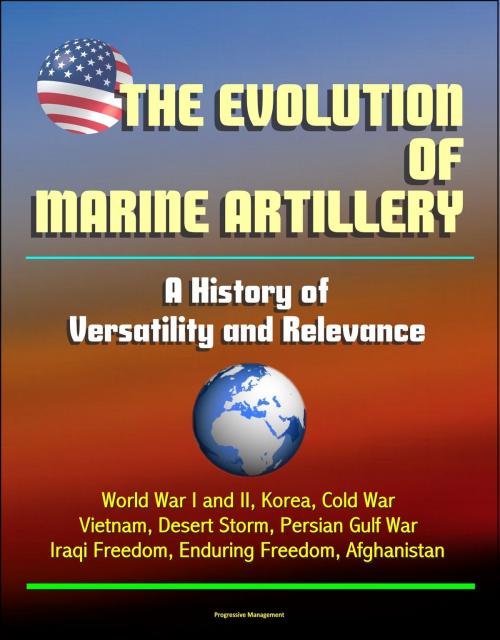The Evolution of Marine Artillery: A History of Versatility and Relevance - World War I and II, Korea, Cold War, Vietnam, Desert Storm, Persian Gulf War, Iraqi Freedom, Enduring Freedom, Afghanistan
Nonfiction, History, Military, Weapons, World War II| Author: | Progressive Management | ISBN: | 9781311017390 |
| Publisher: | Progressive Management | Publication: | January 5, 2016 |
| Imprint: | Smashwords Edition | Language: | English |
| Author: | Progressive Management |
| ISBN: | 9781311017390 |
| Publisher: | Progressive Management |
| Publication: | January 5, 2016 |
| Imprint: | Smashwords Edition |
| Language: | English |
Professionally converted for accurate flowing-text e-book format reproduction, this book provides a history of Marine artillery from early years through the Iraq and Afghanistan War.
Marine artillery has forged a 110 year legacy of providing innovative, resilient, versatile, and evolving support to the Marine Corps; it is in this spirit that Marine artillery will continue to support the Marine Corps as the character of war changes in the 21st century. Since its inception, Marine artillery has persevered with a sense of resilience and versatility to enable it to provide whatever support was required. It took decades for the Marine Corps to acquire an artillery capability, but once it did so Marine artillery proved its value and versatility. Still, as early as World War I, Marine artillery performed duties outside of its normal artillery fire support roles in an effort to remain relevant to the needs of the Corps by training on new weapons or performing infantry duties. During World War II, Marine artillerymen served in six artillery regiments as well as other units associated with two Marine Amphibious Corps. Following the war, Marine artillerymen performed various occupational duties along with infantry in Japan and China. The Korean War era demonstrated that Marine artillery, though seriously undermanned, was resilient to provide sufficiently trained artillerymen for combat operations. Marine gunners continued to innovate with new tactics, weapons systems and equipment for the past 60 years through its experiences during the Cold War, Vietnam, Desert Shield/Desert Storm, Operation Iraqi Freedom, and Operation Enduring Freedom. After operations in Somalia and with the introduction of effects based targeting, Marine artillery began facing an expanding role of duties in addition to normal artillery support.
The assignments of non-artillery duties in support of counterinsurgency operations in Iraq to Marine artillery units as well as individual artillerymen has placed a significant burden on the ability of Marine artillery to maintain its "core" competency in artillery missions. The future for Marine artillery as well as the Marine Corps looks lean and challenging. However, after every post war experience that the Marine Corps faced for the past 90 plus years, a force reduction has occurred as well as a general reorganization within the Marine Corps. Following combat operations in Afghanistan in the very near future, the Marine Corps will get smaller which will require another reorganization of Marine artillery.
Leaders within the Marine artillery community have already begun that reorganization for the purposes of regaining core competencies. However, it will be imperative for leaders in the Marine Corps and Marine artillery to understand that due to the length of time that Marine artillery has performed these nonstandard missions in recent years (a period significantly longer than any other period in history), this issue will take years to correct. Fortunately, Marine artillery has demonstrated time and time again its resilience to rise to the challenge in its support of the operating forces of the Corps as conflict has changed.
Professionally converted for accurate flowing-text e-book format reproduction, this book provides a history of Marine artillery from early years through the Iraq and Afghanistan War.
Marine artillery has forged a 110 year legacy of providing innovative, resilient, versatile, and evolving support to the Marine Corps; it is in this spirit that Marine artillery will continue to support the Marine Corps as the character of war changes in the 21st century. Since its inception, Marine artillery has persevered with a sense of resilience and versatility to enable it to provide whatever support was required. It took decades for the Marine Corps to acquire an artillery capability, but once it did so Marine artillery proved its value and versatility. Still, as early as World War I, Marine artillery performed duties outside of its normal artillery fire support roles in an effort to remain relevant to the needs of the Corps by training on new weapons or performing infantry duties. During World War II, Marine artillerymen served in six artillery regiments as well as other units associated with two Marine Amphibious Corps. Following the war, Marine artillerymen performed various occupational duties along with infantry in Japan and China. The Korean War era demonstrated that Marine artillery, though seriously undermanned, was resilient to provide sufficiently trained artillerymen for combat operations. Marine gunners continued to innovate with new tactics, weapons systems and equipment for the past 60 years through its experiences during the Cold War, Vietnam, Desert Shield/Desert Storm, Operation Iraqi Freedom, and Operation Enduring Freedom. After operations in Somalia and with the introduction of effects based targeting, Marine artillery began facing an expanding role of duties in addition to normal artillery support.
The assignments of non-artillery duties in support of counterinsurgency operations in Iraq to Marine artillery units as well as individual artillerymen has placed a significant burden on the ability of Marine artillery to maintain its "core" competency in artillery missions. The future for Marine artillery as well as the Marine Corps looks lean and challenging. However, after every post war experience that the Marine Corps faced for the past 90 plus years, a force reduction has occurred as well as a general reorganization within the Marine Corps. Following combat operations in Afghanistan in the very near future, the Marine Corps will get smaller which will require another reorganization of Marine artillery.
Leaders within the Marine artillery community have already begun that reorganization for the purposes of regaining core competencies. However, it will be imperative for leaders in the Marine Corps and Marine artillery to understand that due to the length of time that Marine artillery has performed these nonstandard missions in recent years (a period significantly longer than any other period in history), this issue will take years to correct. Fortunately, Marine artillery has demonstrated time and time again its resilience to rise to the challenge in its support of the operating forces of the Corps as conflict has changed.















